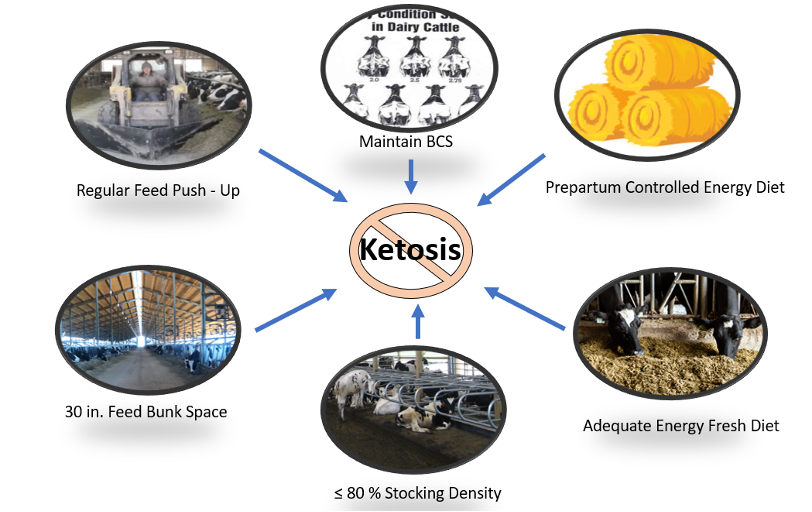Emily S. O’Meara and Dr. Phil Cardoso
February 2024
During the transition period—the three weeks before calving and the three weeks after calving—the dairy cow goes through many metabolic changes that leave her vulnerable to metabolic disorders. She decreases her dry matter intake by ten to thirty percent seven days before calving; meanwhile, during this time her energy demands increase due to lactogenesis and fetal growth. The onset of lactation further exacerbates energy loss, and the cow cannot consume enough nutrients to meet her needs. She therefore mobilizes adipose tissue and muscle tissue to use for energy. Ketone bodies are produced when fatty acids are broken down in the liver for energy use. One of these ketones is beta-hydroxybutyrate (BHB), which can be easily measured in the blood and milk to diagnose ketosis. Ketosis can be subclinical or clinical. In clinical ketosis, the cow shows symptoms such as reduced feed intake, reduced milk production, and lethargy. In extreme cases, nervous ketosis can result, with the nervous system affected causing pica and abnormal licking. Subclinical ketosis is defined as having blood BHB concentrations of 1.2 mmol/L or higher with no clinical symptoms.
Ketosis is a costly metabolic disorder that is estimated to cost a producer, on average, $749 for a clinical case and $159 for a sub-clinical case. These costs include milk loss, veterinary care, and future milk production loss.
Several management practices should be implemented to reduce ketosis in herds. Cows that are over-conditioned prepartum have a higher prevalence of ketosis postpartum. It is recommended to achieve a body condition score (BCS) of 3.0 (scale 1–5) during the prepartum period. A postpartum change of more than 1.0 point in BCS can predispose cows to ketosis as well. Feeding a controlled energy diet (1.40 NEL Mcal/kg of DM) with the inclusion of straw can help limit energy prepartum and maintain BCS score during this time. However, the prepartum period may be too late in controlling BCS, and management should start during late lactation by increasing energy from fiber sources. Providing adequate energy postpartum is crucial to the prevention of ketosis as well. A moderate starch diet (approximately 25%) with adequate neutral detergent fiber (NDF) along with fatty acids should be fed to achieve appropriate energy intake (1.60 – 1.70 Mcal/kg of DM).

Non-nutritional factors and management needs should be considered as well. The stocking density of the fresh pen should be below or at 80% to provide adequate lying space and decrease competition at the feed bunk. Increasing dry matter intake (DMI) in fresh cows by one pound translates to two additional pounds of milk; therefore, providing adequate feed bunk space of thirty inches in fresh cows is vital. Frequent feed push-up is simple and easy to implement to increase DMI. It is most critical one to two hours after fresh feed delivery. In fact, pushing feed up every half hour after feed delivery has been shown to increase milk yield by four pounds per cow per day. When grouping cows, primiparous cows should be grouped separately from multiparous cows to avoid competition and decreased performance of primiparous cows.
Citations
Armstrong, D. V., T. R. Bilby, V. Wuthironarith, W. Sathonghorn, and S. Rungruang. 2008. Effect of different feed push-up schedule on milk production, feed intake and behavior in Holstein dairy cows. J. Anim. Sci. 86:253 (Abstr.).
Cardoso F. C. 2017. Pre- and postpartum nutritional management to optimize energy balance and fertility in dairy cows. Proceedings of the Florida Ruminant Nutrition Conference, February 7 & 8, 2017 – Gainesville, FL. Pages 71-85.
Cardoso, F.C., K.F. Kalscheur, and J.K. Drackley. 2020. Symposium review: Nutrition strategies for improved health, production, and fertility during the transition period. J. Dairy Sci. 103:5684–5693. doi:10.3168/jds.2019-17271.
Steeneveld, W., P. Amuta, F. J. S. van Soest, R. Jorritsma, and H. Hogeveen. 2020. Estimating the combined costs of clinical and subclinical ketosis in dairy cows. PloS ONE. 15(4):e0230448. https://doi.org/10.1371/journal.pone.0230448.
Robertson, L. and D. M. Amaral-Phillips. What is the Optimum Stocking Density for Your Housing System? University of Kentucky. Department of Animal and Food Sciences.
Rabelo E., R. L., Rezende, S. J. Bertics, and R. R. Grummer. 2003. Effects of transition diets varying in dietary energy density on lactation performance and ruminal parameters of dairy cows. J. Dairy Sci. 80:916-925. https://doi.org/10.3168/jds.S0022-0302(03)73674-1.
Figure adapted from:
Boyl M. 2020. Small changes in fresh cow management have big impacts. Zoetis. Parsippany-Troy Hills, NJ.
Elanco. Body Condition Score Sheet. Greenfield, IN.
Lunak M. 2023. Feed delivery and timely feed push ups can improve milk production. Penn State Extension.
Marawood Construction Services, Altoona, WI. https://www.marawood.com/. Accessed 9/28/2023.

